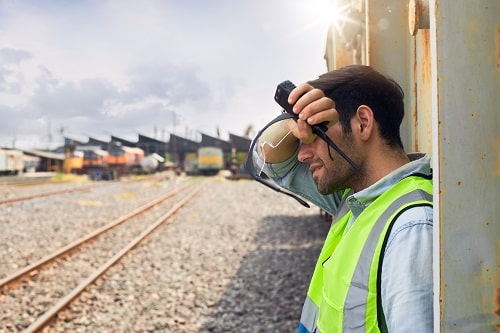Opinion
Preventing silicosis: key recommendations for government and HSE to consider
Silicosis is considered to be the most common chronic occupational lung disease worldwide. It is a form of pneumoconiosis and is a progressive, degenerative clinical respiratory condition which causes crippling health conditions and co-morbidities and can lead to death.
The Health and Safety Executive (HSE) refers to silica as “the biggest risk to construction workers after asbestos”.
An estimated 600,000 workers are exposed to silica in the UK each year. The Institution of Occupational Safety and Health (IOSH) estimates that in Europe as a whole, 81 per cent of those exposed are employed in construction or in manufacturing products used in that industry.
The real tragedy of silicosis is that it is totally preventable.

The All-Party Parliamentary Group on Respiratory Health decided to investigate the clinical and regulatory systems in place in the UK to examine whether there were solutions to this and what more could be done to help improve workers’ health. We consulted with industry and the regulatory bodies to establish the current situation and what we could do to help. In all our considerations, the wellbeing and safety of workers and those exposed to respirable crystalline silica (RCS) was paramount.
The industry and the other stakeholders were extremely generous with their time and we published our report, Improving Silicosis Outcomes in the UK, in January this year.
The report contained a number of key recommendations for government and HSE to consider.
We identified the need to increase awareness of the dangers of working with silica-related products and one of our recommendations was aimed at getting it right from the start. We urged the Department for Education to consider the inclusion of silica-related risk as a compulsory syllabus item for all building and construction modules in government-funded apprenticeship schemes and further education courses.
This would have two effects. Firstly, it would instil in those considering entering silica-related industries the skills and knowledge needed to take safety concerns around RCS through the rest of their careers; and secondly, it would also provide knowledge and application on the job.
Industry awareness campaign required on the dangers of silica
To assist with the raising of awareness, we also recommended that HSE conduct an industry awareness campaign on the dangers of respirable crystalline silica to improve compliance with the existing Workplace Exposure Limit (WEL) for RCS. HSE awareness campaigns have been very successful in the past and although silica-related issues have been included in other awareness campaigns, we believe it warrants its own campaign.
We also explored the current WEL limit in the UK and whether the UK limit should be reduced. HSE recognised the need for exposure limits to be based on the best available science and with sufficient evidence that any new level would reduce ill-health relating to RCS exposure. They stated that they review all relevant, peer-reviewed evidence on exposure levels that show tangible health benefits relevant to workers.
They told us that if evidence is presented for a new workplace exposure limit, there would be a full consultation and cost benefit analysis as part of introducing any change.
We accept the process necessary to reduce the WEL and we believe that HSE’s approach is right. We intend to work with them to determine the necessary data that is needed to look at this again.
Real time monitoring of RCS dust levels and exposures
A central part of our inquiry was into real time monitoring to see if there were any benefits over the current system. We looked closely at the monitoring of RCS and the methods that are presently conducted within the industry and we had two major concerns regarding current monitoring methods:
- The amount of time taken to deliver exposure results
- The limitations of average exposure data.
- The current gravimetric assessment requires technical equipment which needs to be calibrated and together with pre-weighed filters and a pump and sampling head in the respirable zone.
- The sample has to be sent away to a laboratory for analysis and will only give results days or weeks post-analysis.
In our evidence we heard of numerous examples of recent technological developments which have introduced automatic real time dust monitoring, although these are not a recognised standard of measurement. The advantages of real time dust monitoring include their consistency and repeatability of results, their small size and ease of use and their ability to provide real time analysis and alerts, that are very attractive to the APPG.
We also heard that there is increasing use of innovative, real time measurement technology to help with identification of dust emission sources and to bring early detection of abnormal exposure situations.
HSE told us they monitor developments in this area, as validation data to confirm accuracy currently remains limited. As with all advances in technology, claims made for any of these instruments would need to be examined further and substantiated with robust data and it is are right to do so.
The APPG strongly believes that the future of regulation in the industry on RCS exposure limits lies in innovative technologies on real time monitoring. In our opinion real time monitoring is a step change ahead of the current system, which is limited due to the lag time for the data. To have to wait days or weeks to be told whether the RCS limits were exceeded or not cannot be ideal – for workers or employers.
We see advances in real time technology as the inevitable future for the industry and we have urged HSE to look into this in more detail. Some respondents were unclear what data sets were necessary to demonstrate the effectiveness of real time monitors against existing control measures and we feel that this needs to clarified by HSE. We have offered to work with them and the silica-related industries to take this further.
We also looked at the clinical context and, in an attempt to assist patients and clinicians, we suggested a number of steps for the Department of Health and Social Care (DHSC).
We recommended prioritising the earlier diagnosis of silicosis as the most effective way to assist patients, including more effective use of data at primary care level to take into account previous employment history, with a flag on work or former work dealing with RCS.
We also recommended potential ways of diagnosing silicosis at an earlier stage through the NHS Lung Health Checks and the Community Diagnostic Centres, where clinicians having access to an individual’s previous employment history (involves exposure to RCS) will be important in determining the need for scans and other diagnostic tests to determine a specific silicosis diagnosis.
The Additional Roles Reimbursement Scheme , which – provides funding for 26,000 additional roles to create bespoke multi-disciplinary teams at primary care level – enabled us to recommend that occupational health services are introduced into more GP surgeries to allow for occupational histories to be taken where RCS work-related ill health is suspected.
As a political group we will now look to take the recommendations of the report further with ministers and the relevant departments. We will look to work with HSE to advance the recommendations and we will examine the existing and upcoming government initiatives related to this, including the Hewitt Review, the Major Conditions Strategy and the new Integrated Care Boards to help place respiratory health in the right context.
Jim Shannon is the Democratic Unionist Party MP for Strangford. He is also Chair of the All-Party Parliamentary Group on Respiratory Health.
APPG on Respiratory Health report, Improving Silicosis Outcomes in the UK, available here.
@AppgHealth
OPINION

Heat at work: a silent killer
By Halshka Graczyk and Lacye Groening, ILO on 07 April 2025
Workers across the world are increasingly being exposed to excessive heat with serious implications for their safety and health. It is therefore vital that governments, employers and workers’ organisations develop, share and implement practical and low-cost strategies and measures for effectively reducing the risk from heat stress at work.

Making good work the foundation
By Mike Robinson FCA, British Safety Council on 07 April 2025
In 2024, for the first time, the UK dropped out of the list of the top 20 happiest countries: according to the World Happiness Index. This year, the UK rests in 23rd place, slightly ahead of the US and behind the Nordic countries, Germany, the UAE and others.

The air we share: why tackling pollution protects us all
By Scott Paul, Mums for Lungs on 04 April 2025
Air pollution is often invisible; its impact is anything but. Whether you’re a parent worried about your child’s lungs, a construction worker breathing exhaust fumes, or a commuter passing through busy streets, polluted air is everyone’s problem.



